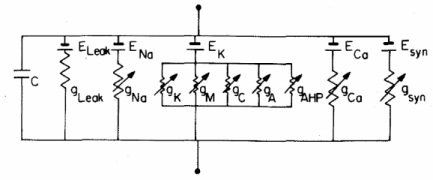Team:Valencia/OurModel
From 2009.igem.org
Our Model
- Modelling Ionic Current Flow through VDCCs
If we assume that the whole calcium currents occur through this calcium channels and that the instantaneous current-voltage relation is linear, we can describe the ionic current ICa by the Ohm's law:
Where g is the conductance associated with the channel, V is the transmembrane potential and ECa is the Nerst potential, related to the different ionic concentration inside and outside the cell.
Considering that these channels are only permeable to calcium and have two states -open or closed-, the total conductance associated with the population of VDCCs can be expressed as the maximal conductance ![]() times the fraction of all channels that are open. This fraction is determined by hypothetical activation and inactivation variables m and h, which depend on voltage and time:
times the fraction of all channels that are open. This fraction is determined by hypothetical activation and inactivation variables m and h, which depend on voltage and time:
![]() is the steady-state value of m and
is the steady-state value of m and ![]() is the time constant. They are defined functions of voltage:
is the time constant. They are defined functions of voltage:
K is the halfway inactivation concentration and [Ca2+]o is the constant extracellular calcium concentration.
Now, we have to model how transmembrane potential changes in time. To do this, we can consider the following membrane-equivalent electrial circuit, where all ionic currents involved in initiation and propagation of the action potential are represented:
We can know the transmembrane potential at any time after applying an electrical input by solving this equation:
However, we have assumed that our stimulus triggers the excitatory post-synaptic potential (EPSP), so it's not necessary to solve the previous equation. But modelling the calcium influx is only the first step...
 "
"












